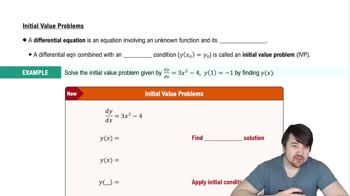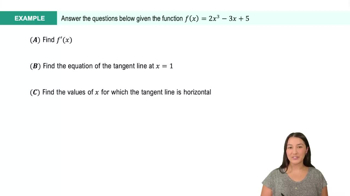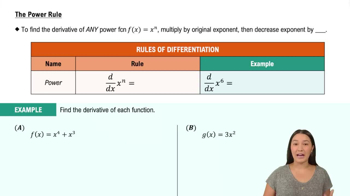Table of contents
- 0. Functions7h 52m
- Introduction to Functions16m
- Piecewise Functions10m
- Properties of Functions9m
- Common Functions1h 8m
- Transformations5m
- Combining Functions27m
- Exponent rules32m
- Exponential Functions28m
- Logarithmic Functions24m
- Properties of Logarithms34m
- Exponential & Logarithmic Equations35m
- Introduction to Trigonometric Functions38m
- Graphs of Trigonometric Functions44m
- Trigonometric Identities47m
- Inverse Trigonometric Functions48m
- 1. Limits and Continuity2h 2m
- 2. Intro to Derivatives1h 33m
- 3. Techniques of Differentiation3h 18m
- 4. Applications of Derivatives2h 38m
- 5. Graphical Applications of Derivatives6h 2m
- 6. Derivatives of Inverse, Exponential, & Logarithmic Functions2h 37m
- 7. Antiderivatives & Indefinite Integrals1h 26m
- 8. Definite Integrals4h 44m
- 9. Graphical Applications of Integrals2h 27m
- 10. Physics Applications of Integrals 2h 22m
3. Techniques of Differentiation
Basic Rules of Differentiation
Problem 3.43b
Textbook Question
City urbanization City planners model the size of their city using the function A(t) = - 1/50t² + 2t +20, for 0 ≤ t ≤ 50, where A is measured in square miles and t is the number of years after 2010.
b. How fast will the city be growing when it reaches a size of 38 mi²?
 Verified step by step guidance
Verified step by step guidance1
Step 1: Identify the function A(t) = -\frac{1}{50}t^2 + 2t + 20, which models the size of the city in square miles as a function of time t in years after 2010.
Step 2: To find how fast the city is growing, we need to determine the rate of change of A with respect to t, which is the derivative A'(t).
Step 3: Differentiate A(t) with respect to t to find A'(t). The derivative of A(t) = -\frac{1}{50}t^2 + 2t + 20 is A'(t) = -\frac{2}{50}t + 2.
Step 4: Set A(t) equal to 38 to find the value of t when the city reaches a size of 38 mi². Solve the equation -\frac{1}{50}t^2 + 2t + 20 = 38 for t.
Step 5: Once you have the value of t, substitute it into A'(t) to find the rate of growth of the city at that time.
 Verified video answer for a similar problem:
Verified video answer for a similar problem:This video solution was recommended by our tutors as helpful for the problem above
Video duration:
6mPlay a video:
Was this helpful?
Key Concepts
Here are the essential concepts you must grasp in order to answer the question correctly.
Function Analysis
Understanding the function A(t) = -1/50t² + 2t + 20 is crucial for analyzing the growth of the city. This quadratic function represents the area of the city over time, where the coefficients indicate how the area changes as time progresses. The vertex of the parabola can provide insights into maximum growth, while the shape of the graph helps in understanding the growth rate at different time intervals.
Recommended video:

Derivatives Applied To Velocity
Derivative and Rate of Change
The derivative of the function A(t) represents the rate of change of the city's area with respect to time. By calculating A'(t), we can determine how fast the city is growing at any given time. This concept is essential for finding the growth rate when the city reaches a specific size, such as 38 mi², as it allows us to evaluate the instantaneous growth at that point.
Recommended video:

Intro To Related Rates
Solving for Specific Values
To find out how fast the city is growing when it reaches 38 mi², we first need to solve the equation A(t) = 38 for t. This involves setting the function equal to 38 and solving for the time variable t. Once we have the appropriate value of t, we can substitute it back into the derivative A'(t) to find the growth rate at that specific moment.
Recommended video:

Initial Value Problems

 3:59m
3:59mWatch next
Master Derivatives of Linear Functions with a bite sized video explanation from Callie
Start learningRelated Videos
Related Practice







